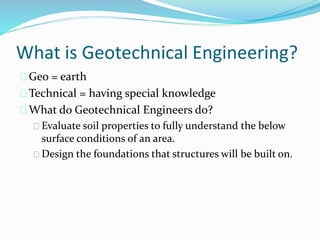An Unbiased View of Geotheta
An Unbiased View of Geotheta
Blog Article
Some Known Factual Statements About Geotheta
Table of ContentsRumored Buzz on GeothetaGeotheta for DummiesGetting The Geotheta To WorkGetting The Geotheta To WorkThings about Geotheta

They conduct site examinations, collect samples, do research laboratory tests, and examine information to evaluate the viability of the ground for building and construction projects - Consulting Engineers. Based upon their searchings for, geotechnical engineers offer referrals for foundation design, incline stability, preserving frameworks, and mitigation of geotechnical risks. They collaborate with various other specialists, such as designers, architectural designers, and construction teams, to make certain that geotechnical factors to consider are incorporated right into the general job layout and application
By evaluating the actions and homes of soil and rock, they can recognize possible geotechnical threats such as landslides, soil settlement, or slope instability. Their knowledge helps avoid failures or crashes that might endanger lives and residential property. Below are some comprehensive duties and duties of a geotechnical engineer: Site Investigation: Geotechnical designers conduct website investigations to gather data on subsurface conditions.
They interpret the information to understand the residential properties and actions of the soil and rock, including their stamina, leaks in the structure, compaction qualities, and groundwater conditions. Geotechnical Evaluation and Layout: Geotechnical designers assess the information accumulated during site examinations to evaluate the security and suitability of the website for construction tasks. They execute geotechnical computations and modeling to examine aspects such as birthing capability, settlement, slope stability, lateral planet stress, and groundwater circulation.
8 Simple Techniques For Geotheta
Foundation Style: Geotechnical engineers play a critical duty in making foundations that can securely sustain the intended structure. They assess the dirt problems and tons requirements to establish the appropriate structure kind, such as shallow foundations (e.g., grounds), deep structures (e.g (https://anotepad.com/note/read/ew8kqmw7)., stacks), or specialized techniques like soil enhancement. They consider factors such as settlement limits, birthing capability, and soil-structure interaction to establish optimal foundation designs
They assess building strategies, display site tasks, and carry out area inspections to validate that the layout recommendations are adhered to. If unpredicted geotechnical problems emerge, they examine the situation and supply suggestions for removal or modifications to the design. Threat Assessment and Mitigation: Geotechnical engineers evaluate geotechnical hazards and dangers related to the job website, such as landslides, liquefaction, or soil erosion.

Cooperation and Interaction: Geotechnical engineers function very closely with various other experts associated with a job, such as designers, architectural designers, and building and construction teams. Efficient interaction and partnership are vital to incorporate geotechnical considerations right into the total job layout and construction procedure. Geotechnical engineers offer technological knowledge, answer inquiries, and make sure that geotechnical needs are satisfied.
Geotheta Can Be Fun For Anyone
Below are some kinds of geotechnical engineers: Structure Designer: Structure designers specialize in designing and evaluating structures for frameworks. They assess the soil conditions, lots needs, and website attributes to figure out one of the most appropriate structure type and style, such as superficial structures, deep structures, or specialized strategies like heap foundations.
They assess the elements influencing incline security, such as dirt residential properties, groundwater problems, and incline geometry, and create approaches to prevent slope failures and reduce dangers. Earthquake Engineer: Earthquake engineers specialize in evaluating and developing structures to endure seismic forces. They examine the seismic danger of a site, assess soil liquefaction potential, and develop seismic layout criteria to make sure the safety and security and resilience of frameworks during earthquakes.
They execute field screening, gather examples, and examine the accumulated information to define the soil residential properties, geologic formations, and groundwater conditions at a website. Geotechnical Instrumentation Designer: Geotechnical instrumentation engineers concentrate on surveillance and gauging the habits of soil, rock, and structures. They mount and keep instrumentation systems that keep track of factors such as dirt settlement, groundwater degrees, slope activities, and architectural displacements to assess efficiency and offer early cautions of potential concerns.
What Does Geotheta Mean?
They conduct tests such as triaxial examinations, combination tests, straight shear examinations, and permeability examinations to gather data for geotechnical analysis and layout. Geosynthetics Designer: Geosynthetics engineers concentrate on the design and application of geosynthetic materials, such as geotextiles, geogrids, and geomembranes. They make use of these materials to enhance soil stability, reinforce inclines, provide water drainage options, and control erosion.
They have a tendency to be investigative individuals, which suggests they're intellectual, introspective, and investigative. They are curious, methodical, reasonable, analytical, and logical. Some of them are also social, indicating they're kind, charitable, participating, client, caring, practical, understanding, sensible, and friendly. Does this audio like you? discover this info here Take our free career examination to discover if geotechnical designer is one of your top profession matches.
In the workplace environment, geotechnical designers make use of specialized software program devices to perform estimations, create layouts, and examine data. They prepare records, testimonial job specs, interact with clients and staff member, and coordinate task tasks. The workplace setting provides a favorable atmosphere for research, evaluation, and cooperation with various other professionals associated with the task.
The Greatest Guide To Geotheta
They regularly check out project websites to perform site examinations, assess geotechnical problems, and gather data for evaluation. These brows through involve taking a trip to various areas, in some cases in remote or tough terrains. Geotechnical designers may perform soil tasting, conduct tests, and screen building and construction activities to make sure that the geotechnical aspects of the job are being implemented properly.
Geotechnical engineers likewise work in specialized geotechnical labs. Geotechnical research laboratory designers function thoroughly in these atmospheres, managing screening tools, running tools, and recording information.
Report this page